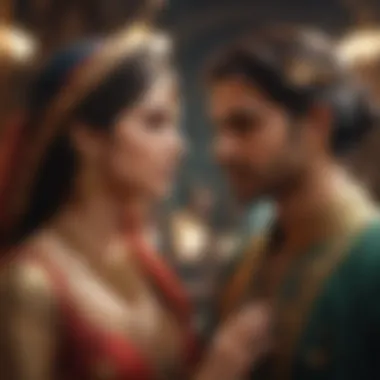Kundali Matchmaking for Marriage: A Detailed Insight


Intro
In the ever-evolving tapestry of human connections, Kundali matchmaking emerges as a time-honored practice that bridges the ancient and the contemporary. With its roots deeply embedded in Indian culture, this method of evaluating marital compatibility goes beyond mere romantic notions. It draws upon philosophies that interweave the cosmic with the earthly, the seen with the unseen, shaping relationships in ways that often defy logic yet resonate profoundly on a personal level.
This exploration seeks to unpack the complexities of Kundali matchmaking—from understanding the intricate details of zodiac signs to the astrological elements that potentially influence our choices and lives. We will delve into how this traditional practice navigates the digital age, shedding light on the significance of astrological compatibility in romantic unions, with the aim to provide clarity and insight for those who's curious about the nuances of this ancient wisdom.
As we embark on this journey, we will also address some of the common myths and misconceptions surrounding Kundali analysis. By the end, the reader will not only be informed but, perhaps, inspired to view their relationships through a different lens. In this digital landscape where traditions meet modernity, understanding Kundali matchmaking serves as a vital compass for those navigating the realm of love and partnership.
Understanding Kundali
Kundali, often referred to as the birth chart, is more than just a celestial map; it is a reflection of an individual’s potential, character, and destiny. In the context of matchmaking for marriage, understanding Kundali is paramount, particularly within Indian culture where astrology holds significant weight. The very act of analyzing one's Kundali can unlock insights that may not just dictate compatibility but also unveil the path that individuals may walk together.
Kundali’s importance extends beyond mere expectations or mystical beliefs. It offers a foundation upon which relationships can be built, provided that the analysis is approached thoughtfully. When selecting a partner, many Indian families consider this astrological framework not merely as a guideline but as a pathway to harmony and mutual understanding based on celestial arrangements.
Definition and Significance
A Kundali consists of intricate elements, including the sun sign, moon sign, and the positions of various planets at the time of one's birth. Each aspect of a Kundali represents unique traits and potential life experiences.
- What It Represents: It serves as an astrological snapshot of an individual's life at the moment of their birth. The placement of planets in various houses within the chart provides insights into personality, career suitability, and interpersonal dynamics.
- Why it Matters: In the matchmaking process, the significance of a Kundali comes into play as families often seek compatibility across multiple layers such as temperament, emotional responses, and even long-term goals. Understanding the depth of a Kundali can illuminate fundamental compatibilities or incompatibilities, making it essential for healthy unions.
The Role of Astrology in Marriage
Astrology plays a central role in marriage within many cultures, especially in Indian customs, where it dictates not just compatibility but also potential future happiness. The belief is that the stars influence relationships and emotions, thus a well-matched partnership can lead to more harmonious living.
- Compatibility Analysis: By examining planetary alignments, astrologers analyze potential for emotional and spiritual compatibility. For instance, the strength of the moon in both partners' charts can guide decisions in emotional support and understanding.
- Timing Matters: Astrology isn't only about who you are with but when you choose to start your journey together. Certain planetary transits are believed to enhance relationships, while others might not be conducive to new beginnings.
- Cultural Beliefs: Many believe that those who don't match astrological parameters might face challenges in their married life. Thus, astrology becomes not just a suggestion but often a demand that shapes marriage practices within many families.
Understanding your Kundali can be a key to reinforcing bonds, but it should be combined with mutual respect and understanding as the real foundation of relationships.
The Basics of Kundali Matchmaking
Kundali matchmaking is at the very heart of traditional marriage practices within many Indian communities. This section aims to shed light on the crucial aspects of the subject, emphasizing its relevance to relationship formation through astrological compatibility. It serves as a foundational pillar for understanding how individuals are paired based on their astrological charts, a process steeped in centuries of tradition yet still pertinent today. For many families, a harmonious union often hinges on the principles of Kundali matchmaking, shaping not only personal relationships but also familial bonds and societal structures.
What is Kundali Matching?
Kundali matching can be best described as the systematic evaluation of the astrological charts of two individuals intending to marry. It isn’t simply about assessing compatibility; it’s more nuanced than that. The practice involves analyzing various factors depicted in one’s birth chart, comparing them with another’s in order to determine how well the two might resonate on both a personal and cosmic level.
At its core, this methodology draws upon the belief that celestial bodies influence human behavior and relationships. It’s also an age-old tradition that families have relied upon for generations, granting an almost sacred sense of validation to the union. Each aspect of the charts—be it strengths or weaknesses—sheds light on potential areas of harmony or conflict between partners.
The Elements of Kundali
The intricacies of Kundali matchmaking can be broken down into several key components that all interrelate.
Birth Chart
The birth chart, or Janam Kundali, holds a significant place in this analysis. It serves as a map of the heavens at the precise moment of an individual's birth. This intricate diagram features planets, signs, and houses, offering insights into one’s life path and personality traits.
A notable characteristic of the birth chart is its individuality. Each chart is unique, created by the exact date, time, and location of birth. This high degree of individuality makes it a beneficial tool for comprehensive compatibility assessments. However, while it can offer profound insights, it does come with challenges, as different interpretations may arise from varying schools of astrology.
Planetary Positions
The planetary positions reveal the arrangement of celestial bodies at one's birth, offering insights into personal traits, tendencies, and potentials. Each planet signifies different aspects of life, and their positioning can drastically alter the interpretation of compatibility.
What stands out about planetary positions is their dynamic nature; they are not stagnant. They change continuously, providing a clear view of evolving traits and circumstances throughout life. This feature is advantageous because it helps couples understand how their relationship might develop over time. Nevertheless, interpreting these positions requires expertise, and relying on novice astrologers could lead to misguided conclusions.
Houses and Signs
In the context of Kundali matchmaking, houses and signs elucidate the areas of life that influence relationship dynamics. The twelve houses represent different life aspects, such as love, career, and family. Coupled with the twelve zodiac signs, which bring specific traits to the fore, these elements create a comprehensive backdrop for analysis.
The appeal of houses and signs lies in their multifaceted nature—this depth allows for a thorough understanding of an individual's behavior and relational tendencies. They serve as guiding points for partners, revealing both strengths and weaknesses. However, one must tread carefully; a small misjudgment here could lead to skewed perspectives on compatibility.
In summary, the elements of Kundali matchmaking are not just theoretical musings; they have real implications for relationships, especially within the context of marriage. Understanding these basics can pave the way for deeper dives into the other considerations and factors that may influence compatibility, showcasing the rich tapestry of tradition and belief surrounding this practice.
The Process of Kundali Analysis


Kundali analysis occupies a significant role in the realm of matching potential partners for marriage. This process is not just about seeing if two people's horoscopes align; it's a nuanced dive into the intricate astrological elements that can sway the dynamics of a relationship. The foundational belief is that the celestial influences at the time of birth shape an individual’s personality and fate. Thus, understanding these influences through Kundali analysis can facilitate harmonious partnerships and long-term compatibility, ultimately steering couples away from potential conflicts and misunderstandings.
Collecting Necessary Information
This stage of the process is paramount, as the accuracy of the Kundali is only as good as the information input. Collecting details regarding a person’s date, time, and place of birth is essential. Each of these elements plays a pivotal role in crafting an accurate birth chart, which serves as the blueprint for the individual's astrological analysis.
Date of Birth
The date of birth is arguably one of the most crucial pieces of information in astrology. It determines the individual's sun sign, which plays a key role in shaping personality traits and tendencies. In this context, the date not only marks the beginning of one's life journey but also sets the stage for the positioning of planets at that specific moment. This characteristic—defining one’s essence—makes it a popular choice for those delving into astrology for matchmaking.
However, relying solely on the date can omit some finer details that are necessary for a comprehensive analysis. It is often regarded as a starting point, leading to the understanding of what else needs to be considered within the chart.
Time of Birth
The time of birth corroborates the exact positioning of the planets within the various houses and leads to a more detailed birth chart. This aspect enhances the Kundali's accuracy. The key characteristic here is precision. Even a difference of a few minutes can lead to notable variances in the interpretation of that person's astrological profile.
This level of detail means that time is not just a minor detail; it becomes a pivotal piece of the puzzle, making the exact time of birth an indispensable factor in Kundali matchmaking. However, there are instances where individuals lack knowledge of their exact birth time, which can complicate the analysis. In such cases, astrologers might rely on other methods to estimate the time for a favorable analysis.
Place of Birth
The place of birth introduces another layer of complexity. It provides geographical perspective, affecting the astrological houses and therefore helping to tailor the reading to the individual's local celestial influences. The key characteristic of this element is its role in contextualizing the birthday’s general astrological impacts with real-world considerations.
Moreover, this piece of information aids in establishing not only relationships with family and friends but also in broader societal interactions. Without this factor, crucial understandings could be missed, thus potentially skewing compatibility readings.
Creating the Birth Chart
Crafting a birth chart is an art in itself that requires precision and an understanding of complex astrological principles. This chart essentially maps out the positions of the planets and stars at the time of one’s birth, providing a celestial snapshot. This snapshot becomes the foundation for examining personality traits, tendencies, and potential life paths. A well-constructed chart tells a story; it's not only focused on the individual's sun sign but encapsulates aspects like their moon sign, ascendant, and planetary placements, contributing to a more comprehensive view of compatibility with prospective partners.
Evaluating Matching Parameters
Once the birth charts are generated, the next logical step is the evaluation of matching parameters—this is where the rubber meets the road in the Kundali analysis. Several key factors are assessed:
Nadi Dosha
Nadi Dosha focuses on the cosmic role of the individual's ‘Nadi’ or pulse. It’s said that if there is a disparity between the Nadi in both Kundalis, it can lead to health issues or discord in the relationship. Recognizing this aspect can prevent problematic alignments in marriages. Thus, Nadi Dosha serves as a critical factor in vetting potential partners.
Guna Milap
Guna Milap evaluates the compatibility by measuring the score based on the ‘Gunas’ or qualities. This comprehensive compatibility assessment helps ascertain if both individuals can navigate the emotional landscapes of a relationship harmoniously. When done properly, Guna Milap can bring to light strengths and weaknesses, with an overall score acting as a guide for a potential match.
Bhakoot Dosha
Bhakoot Dosha looks at the relationship’s potential impact on finances and overall life stability. A correct analysis can reveal if there will be challenges or if things can flow smoothly, making it an unavoidable element in preparation for marriage.
In essence, the evaluating parameters act as the compass for matching couples. Each factor adds layers of understanding required to make informed decisions about romantic partnerships that align not just for the present but also for the future.
Factors Influencing Compatibility
When delving into the realm of Kundali matchmaking, it is of paramount importance to understand the various factors that shape compatibility between prospective partners. This analysis goes beyond mere star signs; it digs deep into the intricate details of an individual's astrological chart to gauge the potential harmony or discord between two lives. Here, we will explore key elements like Lagna considerations, the Planetary Dasha sequence, and the vital aspects of emotional and intellectual compatibility that play integral roles in this matrimonial landscape.
Lagna (Ascendant) Considerations
The term Lagna, often referred to as the ascendant, is a fundamental element in Kundali analysis. It represents the zodiac sign that was rising on the eastern horizon at the exact time of one's birth. This position is immensely significant as it not only dictates personal traits but also provides insight into how an individual perceives the world.
- It serves as the foundation for assessing character traits, revealing how they might engage with others. A strong Lagna can indicate confidence and self-awareness.
- When comparing two individuals’ Lagna, astrologers look for compatibility in characteristics. For example, someone with a Taurus Lagna may find compatibility with someone who has Virgo Lagna, as both are earth signs and tend to appreciate stability and reliability.
Thus, compatibility isn't just about sun signs; the Lagna can illuminate the behavioral patterns and tendencies each partner brings to the relationship, helping clarify potential challenges.
Planetary Dasha Sequence
The Planetary Dasha, or periods ruled by different planets in an individual's life, represents a unique rhythm and timing that influences decisions and experiences. Each planet's influence happens according to its specific time frame, fundamentally affecting personality and behavior during those cycles.
- For instance, during a period dominated by Saturn, individuals might feel a strong drive for discipline and responsibility, whereas a Venus Dasha might bring lightheartedness and a desire for connection.
- Understanding these cycles can offer insights into when a person might be more susceptible to challenges or opportunities in a relationship.
It's significant to not only look at one's own Dasha sequences but also to consider how these align or clash with a partner’s sequences. This can reveal the potential for growth or tension in the relationship based on timing and planetary influences.


Emotional and Intellectual Compatibility
Being intellectually and emotionally aligned with a partner cannot be overstated in its importance. This compatibility speaks to how well two partners resonate on deeper levels, beyond superficial attractions.
- Emotional compatibility refers to the ability of partners to understand and support each other's feelings. For example, someone with a Cancer moon might connect well with a Pisces moon, as both water signs tend to be empathetic and intuitive.
- Intellectual compatibility hinges on shared interests, values, and communication styles. It poses the question: can both individuals engage in stimulating conversations, stimulating growth together?
A marriage founded on solid emotional and intellectual grounds is like building a house on a sturdy foundation. Without such a base, even the most meticulously aligned stars could lead to the establishment of a fragile relationship.
In essence, these factors do not merely complement each other—they represent the tapestry of human experience within relationships. A thorough understanding of these elements not only facilitates discerning compatibility but also fosters an environment for mutual growth and understanding.
By highlighting factors like Lagna considerations, the Planetary Dasha sequence, and emotional alongside intellectual coalescence, we embark upon a holistic approach to recognizing how two individuals can strategically weave their lives together in harmony.
Cultural Perspectives on Kundali Matchmaking
In understanding Kundali matchmaking, one cannot overlook the rich tapestry of culture that surrounds it. The practice is not merely a method for determining marital compatibility; it’s an intricate dance of societal values, family traditions, and individual beliefs. This section will delve into the traditional views surrounding Kundali matchmaking, as well as how modern adaptations have reshaped this ancient practice in today’s world.
Traditional Views
The roots of traditional Kundali matchmaking stem from a deep-seated belief in astrology. For many in Indian society, astrological compatibility serves as a pivotal cornerstone of marital arrangements. It’s not simply about two individuals loving each other; it’s about ensuring that they align cosmologically. Families often consult astrologers, who interpret the planetary positions to forecast a couple's potential harmony. This attunement to the cosmos reflects a broader worldview, underscoring the importance of fate and the universe in human relationships.
In traditional settings, the Kundali—the astrological chart—is seen as a guideline that can predict issues that might arise during a marriage. Many believe that the mismatching or misalignment of planetary positions can lead to conflict and stress after tying the knot. This sentiment leads to the saying, "A good astrological match is like a well-oiled machine—smooth and trouble-free."
Families take pride in finding the perfect match, often turning to astrology as a science, while friends and relatives partake in discussions, steeped in cultural nuances. The belief in these traditional practices often serves the dual purpose of comforting families and solidifying social ties.
Modern Adaptations
While cultural traditions hold a firm grip on Kundali matchmaking, the winds of change have started to blow through this practice. The entry of the online realm into matchmaking systems has revolutionized how people perceive and engage with astrological compatibility.
Online Platforms
Online platforms such as Jeevansathi.com and Shaadi.com have taken the matchmaking game up several notches. These virtual spaces have simplified the process, enabling users to access a wealth of profiles from the comfort of their homes. The key characteristic of these platforms lies in their ability to offer tailored options based on individual preferences, merging technology with tradition.
Here’s how online platforms contribute effectively:
- Wider Reach: They open avenues to potential partners beyond geographical boundaries.
- Customized Algorithms: Many utilize algorithms that match not only based on Kundali but also personal interests and lifestyles.
However, one must tread carefully; the online space can sometimes lead to misrepresentation of profiles, raising concerns about authenticity.
Personalized Services
Personalized services offer another innovative approach to Kundali matchmaking. These include tailored consultations where astrologers analyze specific Kundalis for matches, rather than an automated system. This unique feature enriches the process and allows for deep insights.
The advantage here is a more nuanced understanding of compatibility factors, demonstrating a human touch that online algorithms lack. Personalized services often provide a holistic view of compatibility—something that can’t be encapsulated by just the stars. For those seeking something deeper, they can find comfort in these tailored services.
On the flip side, these personalized offerings can be costlier, which might deter individuals on a tighter budget. Nonetheless, the depth of analysis can often outweigh the expense, making it a worthwhile investment for many.
As perspectives on Kundali matchmaking continue to evolve, understanding these shifts enables individuals to choose paths that resonate with their own beliefs while navigating through a complex but intriguing practice.
Addressing Common Misconceptions
In any traditional practice, especially one as intricate as Kundali matchmaking, it’s common for misunderstandings to arise. These misconceptions not only cloud the true essence of the practice but can also detract from its benefits. Clarifying these misunderstandings is crucial, particularly for astrologers, tarologists, and esotericists who aim to provide an accurate representation of these age-old customs.
Astrology versus Science
Astrology often gets the short end of the stick when compared to science. However, this juxtaposition is somewhat misleading. While science relies heavily on empirical evidence, astrology is built more on the observation of celestial patterns and their correlations with human behavior and events.
To many, astrology appears fluffy or mystic, especially in a world driven by black-and-white rationale. Yet, one must acknowledge that historically, even the greatest scientists were once fascinated by the stars; figures like Galileo were also astrologers. This intersects science and astrology in surprising ways. Here’s how to think about it:
- Astronomy's Roots: Simply put, astrology and astronomy were once indistinguishable. Early astronomers studied the heavens not just for navigation but also for guidance in human affairs.
- Statistical Correlation: Some sociological studies suggest statistical correlations between astrological predictions and actual events in life. This data, albeit not universally accepted, points to the impact celestial movements may have on earthly happenings.
- Introspection versus Prediction: Astrology encourages self-reflection which can lead to personal growth. This contrasts with the often-dismissed dogma of a purely scientific approach.
In summary, dismissing astrology outright misses the complexity of human experience. Each discipline offers unique insights, and understanding that astrology doesn’t negate science might enhance both.
Is Kundali Matchmaking Foolproof?


The belief that Kundali matchmaking is ‘foolproof’ is another common misconception. Some individuals enter the arena with the expectation that a perfect match will be delivered without flaws or room for conflicts. The reality is far more nuanced. Here are key factors to consider:
- Influence of Free Will: While Kundali analysis weighs various astrological factors, it does not operate in a vacuum. The human element—individual choices, experiences, and emotional intelligence—play a pivotal role in any relationship.
- Astrology as Guidance, Not Determinism: Kundali matchmaking is meant to inform rather than dictate. Think of it as a roadmap; while it offers good routes, the journey still depends on how you navigate the path.
- Cultural Dynamics: In diverse cultures, traditions may shift how astrology is interpreted. A placement deemed adverse in one context might be incredibly favorable in another depending on cultural dynamics. Hence, one must be cautious not to generalize results across every scenario.
Ultimately, while Kundali matchmaking serves as a valuable tool in assessing compatibility, treating it like a crystal ball overlooks the complexity of human relationships. Moving forward, one must appreciate that, while useful, it does not override individual experiences and emotional engagements.
Understanding the limits of Kundali matchmaking enriches its role in personal relationships, offering insights that support rather than dictate choices.
By addressing these misconceptions, individuals can engage with Kundali matchmaking more openly and thoughtfully, appreciating the practice for what it truly offers—a blend of guidance, insight, and the wisdom of ages.
The Impact of Gender in Matchmaking
Understanding the role of gender in Kundali matchmaking is vital for unraveling how marriages are approached in different communities. Gender considerations permeate the practice, shaping perceptions and expectations about compatibility. Men and women often face dissimilar circumstances governed largely by cultural norms, thus influencing matchmaking outcomes. This section delves into these gendered dynamics, emphasizing how each perspective contributes to the overall framework of Kundali analysis, as well as the particular challenges faced by women in this intricate tapestry.
Male and Female Perspectives
Traditionally, men are seen as key players in deciding marital choices. In many households, liberal views about marriage still tether to age-old customs where males typically hold more power, even in matters as personal as compatibility based on Kundali. A man’s birth chart might carry significant weight, leading to formulations of a match that align favorably with his aspirations or familial status.
Conversely, women often navigate a more complex web of expectations. Their personal desires, too, are shaped by the Kundali match, but cultural pressures tend to steer them towards compliance rather than assertion. For instance, many females experience societal pressure to prioritize family arrangements over their preferences, particularly in contexts where arranged marriages are common. Their cosmic alignment, evaluated less rigorously, may come with a caveat—such as being urged to compromise on their criteria for compatibility.
These differences reflect not only the practice of Kundali matching but also wider societal norms. Male and female perspectives often revolve around distinct hopes, fears, and values, creating a landscape where outcomes vary depending on who is navigating the process.
Challenges Faced by Women
Women grappling with the intricacies of Kundali matchmaking frequently encounter specific hurdles that can undermine their agency. One primary challenge is the persistent societal pressure to conform to traditional ideals of marriage, often sidelining personal happiness or compatibility for familial expectations. These expectations can manifest in several ways:
- Limited Choices: Often, women's choices are heavily influenced by their family's wishes, severely restricting their options in marital partners.
- Emotional Scrutiny: Women are more likely to be scrutinized emotionally, with their compatibility being evaluated against their perceived ‘suitability’ rather than innate qualities.
- Time Pressure: As women approach certain ages, societal norms can push them into hastily arranged matches, leading to decisions marked more by urgency rather than deep consideration of astrological compatibility.
These challenges underscore the need for a shift in perception and practice within the context of Kundali matchmaking. Understanding gender dynamics and actively fostering conversations that prioritize women’s needs can lead to a more balanced approach in this area.
"In the grand symphony of matchmaking, it is essential that every note harmonizes, equally considering the strengths and aspirations of both genders."
Ultimately, the role of gender in Kundali matchmaking illustrates the interplay of tradition and modernity. While male preferences might sometimes dominate, the dialogues surrounding women’s roles are slowly evolving—a crucial factor in enhancing the practice and adapting it to contemporary realities.
Future of Kundali Matchmaking
The future of Kundali matchmaking holds a significant place in understanding how this age-old tradition is evolving alongside societal changes. As global perspectives shift and new methods of connection arise, Kundali matchmaking is no longer restricted to traditional parameters. This section delves into the upcoming trends and innovations shaping the landscape of astrological matchmaking, highlighting the benefits and considerations that accompany these transformations.
Emerging Trends
In recent years, one can observe an intriguing movement toward a more fluid interpretation of Kundali matchmaking. The once rigid frameworks that dictated compatibility have begun to incorporate broader aspects of personality and lifestyle choices. Here are some notable trends:
- Holistic Compatibility: Individuals increasingly seek a more comprehensive understanding of themselves and their partners. This involves looking beyond just astrological charts to include emotional intelligence and shared values.
- Diversity and Inclusion: There's a growing acceptance of varied astrological practices, integrating perspectives from different cultures. As love knows no boundaries, this trend reflects the broadening horizons of relationships today.
- Personalized Experiences: Many are turning to customized matchmaking services that take into account personal preferences. Such trends flourish on user-generated profiles, allowing for a tailored approach to compatibility.
"The future of love doesn’t just rely on the stars but also on the desires and dreams of two individuals."
These emerging trends signify a shift towards a more nuanced understanding of relationships, providing individuals with a framework that speaks to their unique needs.
Technological Innovations
Technology is undoubtedly redefining the way people navigate their romantic endeavors, and Kundali matchmaking is no exception. Here’s how technology is enhancing this field:
- Astrology Apps: Mobile applications now offer convenient access to Kundali analysis, granting users the ability to evaluate compatibility on-the-go. These tools often use algorithms that align with traditional astrological principles while simplifying user experience.
- Online Matchmaking Platforms: Websites that specialize in astrology-based matchmaking are revolutionizing how individuals meet. They provide interfaces that allow users to input details like date, time, and place of birth easily. This results in full-fledged Kundali analyses that can be shared and compared within communities.
- AI-Driven Insights: Artificial Intelligence is beginning to play a role in Kundali matchmaking. By analyzing vast datasets and identifying patterns, AI can provide insights that would require extensive manual labor, thus speeding up the process while maintaining accuracy in predictions.
- Virtual Consultations with Astrologers: The rise of video conferencing technology has opened doors for consultations with astrologers anywhere in the world. This alleviates geographic constraints, allowing people to seek expert advice tailored to their individual needs and situations.
The marriage of technology and astrology promises a future where Kundali matchmaking evolves into a user-friendly, inclusive, and dynamic field, ensuring that the stars remain aligned for those seeking love.
Ending
In wrapping up our exploration of Kundali matchmaking, it’s essential to reflect on the profound significance this traditional practice holds, especially in the context of marriage in Indian culture. At its core, Kundali matchmaking serves as a bridge between two families, steeped in an age-old belief system that seeks to align the stars—not just for love but for long-term compatibility and harmony.
Understanding the intricacies of Kundali analysis is crucial. The details encapsulated in a Kundali, from planetary alignments to the Nadi Dosha, offer deep insights that can guide individuals in their marital journeys. It’s a tapestry woven with factors that extend beyond mere romantic connection, encompassing emotional stability and mutual respect, which are pivotal for any partnership.
Final Thoughts on Kundali Matchmaking
Kundali matchmaking is not simply about matching two charts; it’s about understanding the essence of human relationships influenced by cosmic patterns. This practice invites reflection and consideration of various elements:
- Holistic Approach: It emphasizes an inclusive view of relationships, looking at personal traits, familial bonds, and astrological influences.
- Cultural Relevance: Within a society that values tradition, Kundali analysis helps preserve cultural identity, ensuring that practices endure through generations.
- Modern Day Application: As the digital age unfolds, adaptations of Kundali matchmaking, such as online services, give rise to new ways of connecting with this ancient wisdom, catering especially to a younger audience who might be more inclined to blend tradition with modernity.
"In matters of marriage, aligning the stars can sometimes reveal truths that the heart can overlook."
Ultimately, Kundali matchmaking addresses the complex interplay of the celestial and the personal. It allows individuals to enter into partnerships with a greater understanding of the forces at play in their lives. Engaging with this practice isn't just about finding a partner; it's about forging a connection that is both meaningful and enduring, attuned not only to earthly concerns but to universal truths as well.







